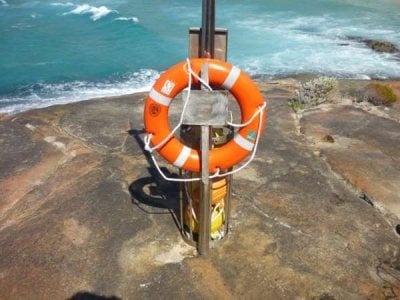Fishmongers advised to avoid one mistake during this major annual event
By
Danielle F.
- Replies 2
As the autumn leaves begin to fall and Easter approaches, the Western Australian coastline turns into a bustling hub of activity.
These activities are not limited to beachgoers but also to thousands of fishers eager to partake in the annual salmon run.
However, with great opportunity comes great responsibility, and those looking to join in on the migration are being cautioned.
The annual salmon run often occurs from Esperance to Perth and peaks between March and April.
This phenomenon has been a fisher's dream as they see waters teeming with salmon along the south coast.
Last week, locals and tourists alike were seen plucking salmon from the water by hand—a testament to the run's abundance.
However, the thrill of catching salmon should not overshadow the importance of safety, nor should it lead to a costly $200 mistake.
The Parks and Wildlife Service of Western Australia recently highlighted the dangers of rock fishing, especially at the Salmon Holes beach in Albany.
Despite the area's allure during the salmon run, authorities warned that conditions would rapidly deteriorate even during 'calm days'.
This could turn the pursuit of salmon into a perilous endeavour for many.
Photos of fishers braving the rough seas sparked outrage and concern among viewers.
The photos also led to calls for banning rock fishing due to the inherent dangers.
The risks of slipping, being swept away by powerful waves, or succumbing to gusty winds are all too real and have tragically claimed people's lives.
The Parks and Wildlife Service advised fishermen to use the installed anchor points in the area and wear life jackets while participating in the salmon run.
Alternatively, the service also suggested standing on the beach as a safer option.
Salmon Holes is the only beach in Western Australia where life jackets are mandatory.
Sara Hands, the Parks and Visitor Services Coordinator from the Department of Biodiversity, Conservation and Attractions (DBCA), confirmed that failure to wear a life jacket on the rocks can result in a $200 infringement.
Should the matter go to court, it could reach up to $1,000, according to the Conservation and Land Management Regulations 2002.
The salmon run also boasts a significant economic impact.
According to a recent study by Recfishwest, WA fishers spend around $331 million annually in pursuit of the salmon.
With roughly 750,000 recreational fishers in the state, the salmon run is both a cultural and recreational highlight that could contribute to the local economy.
Since the beginning of this year's salmon run, rangers have already issued two infringements and four cautions.
Here are some of the sights during a salmon run:
Source: Recfishwest/YouTube
No injuries have been reported as of writing.
Ms Hands urged the public to heed the warnings, use the anchor points, and wear the life-saving vests.
She reiterated that fishing from the beach could also be the safest option for many.
For seasoned fishers and those new to the salmon run, safety should always come first.
The excitement of the catch should never compromise your well-being.
So, before casting your line, make sure you're well-equipped with the necessary safety gear and knowledge of the local regulations.

Have you participated in this annual event before? What precautions do you take to ensure a safe and enjoyable fishing trip? Share your stories and tips in the comments below!
These activities are not limited to beachgoers but also to thousands of fishers eager to partake in the annual salmon run.
However, with great opportunity comes great responsibility, and those looking to join in on the migration are being cautioned.
The annual salmon run often occurs from Esperance to Perth and peaks between March and April.
This phenomenon has been a fisher's dream as they see waters teeming with salmon along the south coast.
Last week, locals and tourists alike were seen plucking salmon from the water by hand—a testament to the run's abundance.
However, the thrill of catching salmon should not overshadow the importance of safety, nor should it lead to a costly $200 mistake.
The Parks and Wildlife Service of Western Australia recently highlighted the dangers of rock fishing, especially at the Salmon Holes beach in Albany.
Despite the area's allure during the salmon run, authorities warned that conditions would rapidly deteriorate even during 'calm days'.
This could turn the pursuit of salmon into a perilous endeavour for many.
Photos of fishers braving the rough seas sparked outrage and concern among viewers.
The photos also led to calls for banning rock fishing due to the inherent dangers.
The risks of slipping, being swept away by powerful waves, or succumbing to gusty winds are all too real and have tragically claimed people's lives.
The Parks and Wildlife Service advised fishermen to use the installed anchor points in the area and wear life jackets while participating in the salmon run.
Alternatively, the service also suggested standing on the beach as a safer option.
Salmon Holes is the only beach in Western Australia where life jackets are mandatory.
Sara Hands, the Parks and Visitor Services Coordinator from the Department of Biodiversity, Conservation and Attractions (DBCA), confirmed that failure to wear a life jacket on the rocks can result in a $200 infringement.
Should the matter go to court, it could reach up to $1,000, according to the Conservation and Land Management Regulations 2002.
The salmon run also boasts a significant economic impact.
According to a recent study by Recfishwest, WA fishers spend around $331 million annually in pursuit of the salmon.
With roughly 750,000 recreational fishers in the state, the salmon run is both a cultural and recreational highlight that could contribute to the local economy.
Since the beginning of this year's salmon run, rangers have already issued two infringements and four cautions.
Here are some of the sights during a salmon run:
Source: Recfishwest/YouTube
No injuries have been reported as of writing.
Ms Hands urged the public to heed the warnings, use the anchor points, and wear the life-saving vests.
She reiterated that fishing from the beach could also be the safest option for many.
For seasoned fishers and those new to the salmon run, safety should always come first.
The excitement of the catch should never compromise your well-being.
So, before casting your line, make sure you're well-equipped with the necessary safety gear and knowledge of the local regulations.
Key Takeaways
- Thousands of fishers visit Western Australia's south coast to participate in the annual salmon run from March to April.
- Authorities warned fishers of the dangers of rock fishing at Salmon Holes Beach due to rough waves and slippery conditions.
- Lifejackets are mandatory at Salmon Holes, and failure to wear one could result in an on-the-spot $200 fine.
- Parks and Wildlife Service rangers have already issued fines and cautions this year.








